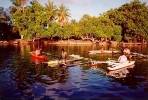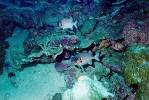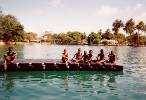|
MADANG: CROSSROAD AT THE CROSSROADS
Madang, Papua New Guinea
Sipping beers at the bar, an Australian artist and a New Hampshire outdoorsman guardedly describe wood carvings they've bought on a canoe trip to remote jungle villages. In a corner, a millionaire industrialist taking a round-the-world yacht trip dines with some of his 15-member crew. At nearby tables, Japanese tourists toting $10,000 underwater cameras relive highpoints of the day's dives. Native New Guineans who'll sell carvings or arrange back-country trekking ply the crowd.
These were among the clientele of the haus win, or open air bar and restaurant, on a recent evening at the Madang Resort
Hotel in this city on Papua New Guinea's northern coast. The mix reflects the diversity of activities in the area -- one reason Madang is a leading tourist destination in Papua New Guinea, a nation of about four million people on a mountainous tropical
island north of Australia.

Madang, which feels much smaller than its population of 300,000,
offers world-class scuba diving reachable with a smooth, 10-minute boat
ride from the shore. With the construction of a new road in the next year
or so, it will become the best coastal staging area for treks into the unbelievably rugged highlands. It's the logical base for a canoe trip through the rain forest flanking the Ramu River, an alternative to the commercial boat trips many tourists take up and down Papua New Guinea's Sepik River to buy carvings and other artifacts from villagers.
The Madang area also offers a pleasant tropical climate in the dry season, generally June to October, and, just offshore, nestled among dazzling coral reefs, tranquil islets edged with sandy beaches and shaded by coconut palms and broad-leafed banana trees.
Madang and Papua New Guinea do, however, present drawbacks that make them less than compelling destinations for many a casual tourist. Papua New Guinea suffers from the urban drift, poverty and crime common to many underdeveloped countries. "Rascals" occasionally rob locals and tourists alike, although much of their activity is confined to a few major cities and highways. In addition, the extremely mountainous terrain
generally makes getting around inconvenient or expensive.
While Madang is relatively free of crime, the range of
accommodations is limited. At the high end, a handful of resorts aren't quite up to international standards, except perhaps when it comes to price. As far as night life goes, a big night is quaffing a few beers at the Country Club, if you know a member who will sign you in.
Nevertheless, Madang and the surrounding area can provide a diverse and exotic getaway for the traveler who is keen on the activities they offer, willing to plan and compromise to control costs, and able to deal with the unavoidable surprises of travel in an under-developed nation.
The rough edges are inevitable in a country known for harboring some of the most primitive regions on the planet. The territory that Papua New Guinea occupies wasn't even claimed by European powers until the 1830s. It wasn't formally colonized until the 1880s and it wasn't thoroughly explored until the 1930s, when the "patrols" operated by the Australian government discovered that most of the people on the island were living in valleys scattered throughout the mountainous interior. Some of these highlanders were head hunters.
As a nation, Papua New Guinea is only 21 years old. Its
underdeveloped economy is dependent on abundant natural resources, including coconut trees, coffee, copper, oil and gold. In fact, a gold rush mentality prevails in some quarters. Nationals, as the native people prefer to be called, talk of extracting the precious metal from their land. Meanwhile, expatriate business people, who also frequent the Madang
Resort Hotel, devise schemes for profiting from a gold mine in the island province of New Ireland; it is expected to be the world's second-largest when production begins next year.
Madang is in fact as much a regional commercial center as a tourist destination. The first group of Western arrivals manned a base for the German New Guinea Kompagnie in the late 19th Century. Today, native people fishing from homemade outrigger canoes dodge ocean-going freighters in the harbor while expats, some on business trips from nearby cities, peddle construction equipment and financial advice.
So far, economic development has done little to disrupt the
attractions that Papua New Guinea offers tourists. The coral reefs in and around Madang Harbor and several other parts of the country teem with a diversity of marine life that at least equals the best of Australia's Great Barrier Reef, which requires a lengthy boat ride to reach. On a recent August afternoon, Barracuda Point, just outside the harbor, lived up to its name by offering up a couple hundred of the pelagics swirling like a tornado in a meandering, doughnut-shaped school.

The reefs are readily available to snorklers too. Boats from the handful of resorts in and around Madang will drop them off at a deserted island beach or lagoon, where brilliant reefs lie within steps of the shore and inches of the surface.
Complementing these natural attractions is an abundance of wrecks, including several dozen World War II ships in Hansa Bay, about 120 miles up the cost from Madang, and a Mitchell B-25 bomber in about 50 feet of water right in the harbor. Japanese divers, in particular, have been known to doff their scuba tanks and jump into the pilots' seats to pose for photographs.
It's only about 120 miles as the cockatoo flies from the harbor's depths to the 14,790-foot summit of Mt. Wilhelm, Papua New Guinea's highest peak. The ascent from one of several lodges at the 9,500-foot level in the tiny village of Kegsugal provides a popular challenge for intermediate-level mountain climbers. The trip is not to be taken lightly. It requires acclimation to the altitude and sufficient warm clothing and bedding; the sun is intense but the temperature generally drops below 40 degrees Farenheit at night. Undertaking the climb without an experienced guide, which costs 30 kina, or about $25, is foolhardy. It took the locals three days to recover the body of a tourist who was without one when he ventured up the peak last year and stepped in
the wrong place.
It's possible to charter an airplane to fly from Madang to the new airstrip in Kegsugal, but the more common means of getting there is a fairly gruelling trip by public jitney and truck that is likely to take two days, with a night in the highlands capital of Goroka and another transfer the next day in Kundiawa. The new road being built from the coast highway outside Madang, expected to be completed by next year, will shorten the journey to one day. The new route also should provide a means of circumventing the rascals that occasionally hold up jitneys on the Highlands Highway.

Between the Madang Province coast and the Highlands lies the Ramu River, where the intrepid might undertake a canoe trip through dense rain forest to visit villages rarely seen by tourists. The wood carvings that can be purchased there are less elaborate than the ones that have helped make the Sepik River one of Papua New Guinea's major tourist destinations. However, they are less likely to have been recently made for tourists, and tend to convey a more primitive feeling.
This too is not an outing for the inexperienced. While
air-conditioned catamarans ply the Sepik, travelers on the Ramu are on their own in procuring canoes, provisions and a local guide, who can arrange accommodations in the villages. One way to start is to contact Martin Borkent, a Dutchman who lives in the village of Usino, through the Lutheran Guesthouse in Madang.
Many visitors to Papua New Guinea will find the primary attraction a visit to a remote village or two. Fortunately, there are some that are easier to get to than the ones on the Ramu. It's possible to reach the village of Bundi from Kegsugal with a 10-hour, mostly downhill hike along the four-wheel drive track to the Coast Highway that is being turned into a road. The route offers some spectacular views. The hike may require a momentary detour through dense forest at the point where road construction is underway. With luck, a ride in a truck servicing the road builders will eliminate the need for six more hours of less scenic hiking between Bundi and a regularly traveled road in Brahmin.
Other villages where one can experience traditional lifestyles can be reached from Madang with varying degrees of difficulty. Some on nearby islands are a 10-minute motor boat ride away. Others along the coast or inland are reachable by four-wheel drive or conventional vehicles. Some local civic leaders are working to put their villages on the map for tourists who want to get off - but not too far off - the beaten path. In Ohu, Hais Wasel, an entymologist, operates a butterfly farm that serves as a draw for occasional day-trippers. In Keki, Moyang Okira, a son of the village chief, has set up a two-night tour that can
include a sing-sing, a display of ceremonial singing and dancing in traditional dress. (A pair of annual, nationwide sing-sing competitions in the highlands are Papua New Guinea's leading tourist events.)

|
For the most part, both locals and tourists stand to gain through further development of natural and cultural attractions. It could help reduce poverty and crime. It could also lead to better transportation; the difficulty of getting around is a leading political issue, and most visitors will find room for improvement without too much commercialization. To the extent that travel by either locals or tourists grows, of course, some of the primitive culture and natural beauty will be lost.
It remains to be seen how successful government leaders will be in addressing social issues and generating greater tourism for Papua New Guinea as a whole. As far as Madang goes, it's likely to become even more popular with respect to the rest of the country with the new road being built, and construction of an international airport is under discussion as well. If tourism grows significantly, some of the primitive culture and natural attractions will become less accessible. However, it's hard to imagine a time when visitors won't be able to test their limits in seeking them out.
|